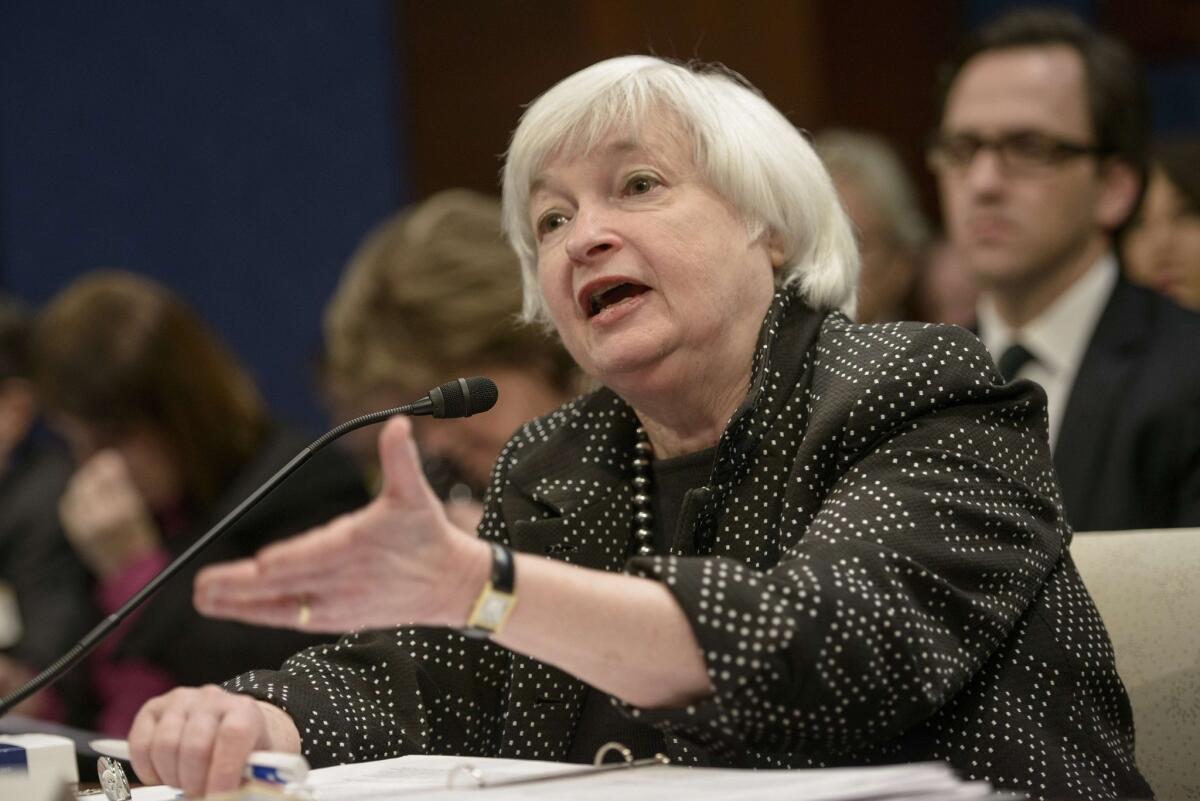Fed sees economy moderating but takes step toward higher interest rates

Federal Reserve officials took a key step toward raising interest rates for the first time since 2006.
Following its two-day meeting Wednesday, the Fed issued a statement that dropped the phrase that said it would be “patient” before raising its benchmark rates. The change opens the door to a rate increase soon.
The statement ruled out a rate increase at the Fed's next meeting in April, putting the focus on June for the first rate hike in nearly a decade. But Fed Chair Janet L. Yellen said the central bank still was in no hurry.
"Just because we removed the word 'patient' doesn't mean we're going to be impatient" about starting to normalize rates, she said at a news conference.
The Fed has kept its main short-term interest rate near zero since December 2008 to boost the economy. A rate hike would have a broad influence on interest rates, raising the borrowing costs for businesses as well as for consumers who have credit cards and mortgages. But it also would give savers a better return on their deposits.
With the “patient” term removed, officials are expected to consider the merits of a rate increase on a meeting-by-meeting basis by examining the latest economic data.
The key statistics for them are employment and inflation. Yellen wants to be confident that the labor market is continuing to make a healthy recovery and that inflation is moving toward the Fed’s target of 2%.
Fed officials gave a more cautious assessment of the economy, noting that "economic growth has moderated somewhat" since policymakers previously met in January.
In addition to the slow housing market, the statement cited weakening growth of exports. The strong dollar wasn't specifically mentioned as a factor, but the greenback's surge in recent months against the euro and some other currencies is seen as making American goods more pricey and less competitive in foreign markets.
The strong dollar also has contributed to declining inflation as it puts downward pressure on prices of imported goods. The Fed noted that inflation had declined further below the central bank's 2% target, thanks largely to falling energy prices, but officials said they expected inflation to move gradually toward their target over the medium term.
Consistent with that, Fed officials lowered their projections for economic growth in their latest forecast.
They now expect gross domestic product, the value of all goods and services produced, to expand 2.3% to 2.7% this year, down from growth of 2.6% to 3% in their December forecast. GDP growth projections for next year also were marked down compared with the forecast at the end of last year.
Fed officials, however, have been pleased with the progress in the labor market, and they again noted "strong job gains." Policymakers also are now looking for the nation's unemployment rate to drop to as low as 5% at the end of this year, compared with 5.2% in their previous forecast. The jobless rate was 5.5% in February.
The projection for near-term inflation also was lowered. Core inflation, which strips out more-volatile energy and food prices, is seen as settling in the range of 1.3% to 1.4% at the end of this year, gradually rising but not hitting the 2% target until 2017.
Some investors and policymakers worldwide are clearly nervous over the Fed’s decision, given risks in the global economy and the interconnectedness of financial markets.
“We are perhaps approaching the point where, for the first time since 2006, the United States will raise short-term interest rates later this year, as the first country to start the process of normalizing its monetary policy,” Christine Lagarde, the International Monetary Fund’s managing director, said in prepared remarks Tuesday.
“Even if this process is well managed, the likely volatility in financial markets could give rise to potential stability risks,” she said.
Jittery investors on Wall Street had been knocking down the blue-chip Dow Jones industrial average and the broader Standard & Poor’s 500, but the indexes shot up immediately after the statement was released.
As in December, 15 of 17 Fed policymakers see rates moving up this year, but they lowered their estimates for how high they would go, suggesting a possible later initial rate hike or slower pace of subsequent increases.
Inside the business of entertainment
The Wide Shot brings you news, analysis and insights on everything from streaming wars to production — and what it all means for the future.
You may occasionally receive promotional content from the Los Angeles Times.








